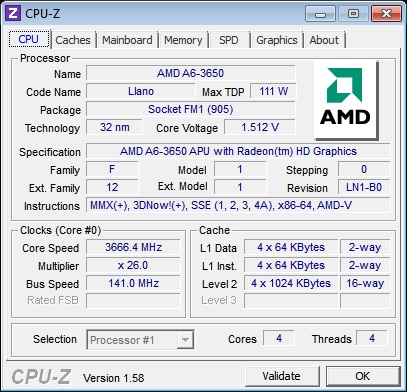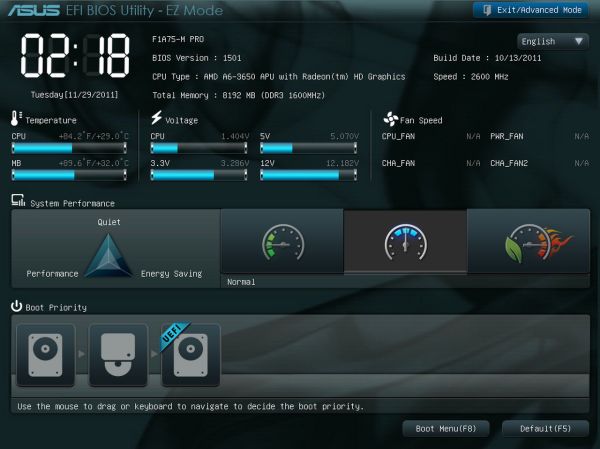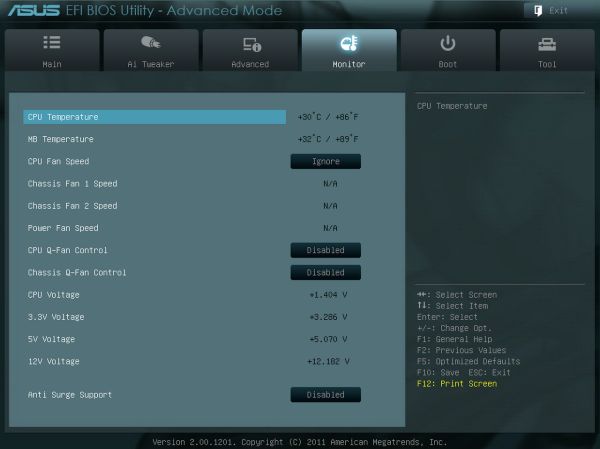ASUS F1A75-M Pro Review - Micro-ATX Llano at $110
by Brendan van Varik on January 22, 2012 2:00 AM EST- Posted in
- Motherboards
- Asus
- Llano
BIOS
As with previous ASUS A75 iterations, our BIOS today is a fully graphical based BIOS - I found it easy to navigate around and find what you are looking for. All of the settings are where you would expect to find them and I feel that ASUS engineers have made this BIOS with ease of use in mind.
The front page of the BIOS contains the basic information of the system along with some voltage readings and temperatures. You can change the boot order here as well by dragging the device which you would like the board to boot from to the front of the list. The three system performance options offer power saving (green), normal (blue), or mildly TPU overclocked (red).
The overclocking section of the BIOS has plenty of settings for you to play around with, including multiplier (with locked APUs only being able to reduce the multiplier), base frequencies, memory strap and voltages either by offset or absolute values. The OC Tuner option does the equivalent of enabling the TPU - under Ai Overclock Tuner, we have some predefined settings for users to enable, assuming their hardware is capable.
Under the monitoring section, you will be able to control three of the four fans, namely the CPU fan and two chassis fans. The fourth fan is a power fan which is not controllable and will always run at full speed.
If you wish to update the BIOS, it is easily done with a USB stick which is formatted to a FAT file system. I was unable to discern noticeable changes between the 1501 BIOS which was used during the review compared to the newest revision (at the time of writing).
Overclocking
If you decide to overclock your system with the automated process in either the BIOS or the software which ASUS provide, the 'OC Tuner', I only got an extra 3 MHz put on to the bus speed, which equates to 78 MHz on the clock speed of the A6-3650 APU (26x100). The voltages remain at stock and the system is stable. The RAM is automatically bumped up to the 1866MHz strap with the correct timings and voltages set which are in the X.M.P profile. Due to the bus being overclocked by 3 MHz, the RAM ends up with a final speed of 1922 MHz with the same timings and 1.65 volts is applied.

When I overclocked the system manually via the BIOS, I was able to achieve a final base clock of 141 MHz at 1.5 V, which gave an overall clock speed of 3666.4 MHz.



















32 Comments
View All Comments
cjs150 - Monday, January 23, 2012 - link
I have found Anandtechs reviews of the IGP to be very helpful, and I agree for boards which could be for an HTPC it would be a good idea to at least link back to the original IGP review.I cannot remember seeing a detailed review of on-board sound from Anand - other than whether it could be channeled through the HDMI port. Great suggestion - ANAND time to pick up on this one.
Whilst there is no need for U-ATX board for an HTPC build I keep looking at a Wesena case and thinking it could look very good
Also ANAND any chance of a review of the Pico-ITX announced by both Zotac and VIA, bit worried about the fans in them, but they could be a really stunning mini-HTPC (although would need to use USB for TV card which is not ideal) also maybe the Zotac AD04 announced at CES
geniekid - Monday, January 23, 2012 - link
FWIW, I use one of these in my HTPC and I haven't had any problems so far.ASUSTechMKT - Monday, January 23, 2012 - link
Kudos and glad to read everything has been smooth!edward2 - Monday, January 23, 2012 - link
PLEASE everyone who wants to buy this MB read this carefully!I bought an Asus F1A75-V Pro MB, before that I've read a lot of review about it and even the asus website specification etc. None of these were mentioning the following:
****These ASUS MBs are not supporting HDMI and DVI-D simultaneous use****
So the whole FM1 platform is completely useless for an HTPC and for a normal setup like HDTV + DVI monitor.
Death666Angel - Monday, January 23, 2012 - link
Then you didn't read very carefully:http://www.asus.com/Motherboards/AMD_Socket_FM1/F1...
"Note *1: HDMI and DVI-D cannot work simultaneously."
I don't really see how this affects the standard HTPC environment though, as I only know people with one TV in their living room. But if you do need that, you have to look elsewhere. :-)
ASUSTechMKT - Monday, January 23, 2012 - link
you can run HDMI/DVI out as the same time as VGA but dual digital output is not supported.Should you want this functionality you can enabled the multi display option within the UEFI and add an additional GPU like a 6500 or 6600 series GPU and then have dual digital output support.
As the user additionally notes this is listed on our support page.
ASUSTechMKT - Monday, January 23, 2012 - link
That is great thanks for the support and glad to read you have had a smooth and solid experience. Do not forgot to check out USB3 Boost which should be posted to your support site shortly or download it from our USB3 Boost landing page directly.rodrigo.dk - Monday, January 23, 2012 - link
I bought one of these in december, and WakeOnLan didn't worked at all. With recent updates it is working ;)D3xx - Monday, January 23, 2012 - link
How would this board and chip compare with an i5 2500 in Z68? Assume both are using 5850 graphics.fluxtatic - Tuesday, January 24, 2012 - link
Are you trolling?On topic, I've got to agree with some of the above - if the graph was labeled correctly, how are you going to publish power consumption numbers on a Llano board with 2 5850s (and then call it typical)? Especially given that half the appeal of Llano is that you don't need discrete graphics at all in most cases?
I can see 1 discrete card for the HTPC market, but likely a low-noise model - lower-end mainstream with either a massive, slow fan, or a colossal heat sink and no fan at all.